Orthodontics
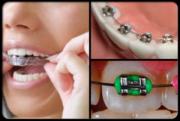 Orhodontics is a discipline which deals with normal teeth ,jaws and face compelex’s structure, developments,abnormalities and treatment of these abnormalities.In the beginning it was more esthetically driven but then later on todays concept of contemporary orthodontics which not only deals with the appearance but with heathy interjaw relationships ,right occlusion etc took over.Lately contrary to how it used to be in the past orthodontics is serving to a wider population and its implications have increased. According to research the fact that preventive dentistry has been widely accepted and applied made the population become more aware and thus a scientifically significant decrease in caries formation is spotted, which made people focus increasingly more on orthodontic treatments applied to people with development abnormalities and deficiencies and bad habitants such as thumbsucking overusing of pacifiers and babybottles,toungethrusters,lipbiters.It is essential to visit an orthodontist to decide whether he will need any orthodontic treatment.
Orhodontics is a discipline which deals with normal teeth ,jaws and face compelex’s structure, developments,abnormalities and treatment of these abnormalities.In the beginning it was more esthetically driven but then later on todays concept of contemporary orthodontics which not only deals with the appearance but with heathy interjaw relationships ,right occlusion etc took over.Lately contrary to how it used to be in the past orthodontics is serving to a wider population and its implications have increased. According to research the fact that preventive dentistry has been widely accepted and applied made the population become more aware and thus a scientifically significant decrease in caries formation is spotted, which made people focus increasingly more on orthodontic treatments applied to people with development abnormalities and deficiencies and bad habitants such as thumbsucking overusing of pacifiers and babybottles,toungethrusters,lipbiters.It is essential to visit an orthodontist to decide whether he will need any orthodontic treatment.
What is the aim of orthodontic treatment ?
- With crowding it is more difficult to maintain oral hygiene and thus gingival problems and caries are more frequently diagnosed,which leads to othodontics to fix the problem of crowding to eliminate the risk of further related diseases.
- With crowding the interjaw relation and the tmj disfuntions may occur which leads to digestive problems since proper biting and chewing can not be done which is also in the field of orthodontics.
- In cases where the relationship between upper and lower teeth is incorrect there may be a n execcive trauma to a tooth or generally to the tmj which by means of an orthodontic treatment can easily be fixed.
- Esthetically some challenging cases can be exremely changed and a new smile design can be obtained by only pure orthodontics without sacrificing tooth structure as with other restorative options such as laminates which is considered as one of the minimally invasive methods of restorative dentistry. That means if indicated orthodontics is a real tissue saving obtion to choose.
What is the idael age for orthodontics?
If the promlems are only teeth related age is not a concern the patient can receive treatment at any age.
If the problem is partly or fully skeletal then age becomes important.In this situation the treatment should be accomplished before puberty. Approximately these orthopedical and orthodontical treatments last longer up to 2 years or sometimes more depending on the case.It has not to be forgotten that adult orthodontics takes a bit longer than the child orthodontics.
What is the best time for the first visit to orthodontics?
With primary teeth dentition parents have to have less concern.The spaces between those teeth are a sign of healthy dental development.If no spaces exist as with adult dentition it may be be the first sign of a further crowding and misalignments.The first permanent teeth erupt between 6-7 years of age but till 7-9 untill the incisors erupt there is no sign of any kind of orthodontic problems.The primary teeth have to be kept in place untill they are replaced with the permanent ones.Even if you are directed at early ages to an orthodontist it does not nean that an orthodontic treatment is going to be started.Most of the time the careful dentist doesn’t want to miss and any condition that indicates an orthodontic application or wants to be sure that it is the right time to intervene.In cases where skeletsl problems are also involveved the trearment has to beginn earlier whereas if the tretatment is only dental there is more time.Today we talk about adult orthodontics where we have no problems in moving teeth wthout age limitations unless there is no problem with supportve surrounding tissues which is a more important subject than age.
Yes nowadays it is possible technologically to do the orthodontic treatment in adulthood and to smile with ones own straight and beautiful teeth make people happier teeth. Actually dentally orthodontic treatments can be done at any time as long asteeth and surrounding periodontal tissues are healthy. There are abnormalities concerning jaws which in adulthood can only be corrected surgically.
What are the causes of the orthodontic problems?
Nutritional Disorders: Those who have malnutrition will not have a 3 dimensional deficiency in facial and jaw development which wiil have have an impact on the crowding since the normal size teeth wont find the space at the underdeveloped smaller size jaws furthermore rotations of the permanent teeth or impaction due to the lack of space may also come accross.
 Mouthbreathing: Cronical inflamations and situations alike that take long may cause tonsills to grow exessively which obturates partly the respiratory tract and it gets hardto breathe in.To avoid it and to widen the airpassage the kid feels like moving his lower jaw and tongue forward. If tis takes long the protrusive posture of the mandible becomes cronic.The tounge thet is between the lower and upper teeth prevents them from proper eruotion and an open bite establishes.If the patient can not breathe thoroughly through his nose there may be a negative impact on the potential development of the upper jaw.
Mouthbreathing: Cronical inflamations and situations alike that take long may cause tonsills to grow exessively which obturates partly the respiratory tract and it gets hardto breathe in.To avoid it and to widen the airpassage the kid feels like moving his lower jaw and tongue forward. If tis takes long the protrusive posture of the mandible becomes cronic.The tounge thet is between the lower and upper teeth prevents them from proper eruotion and an open bite establishes.If the patient can not breathe thoroughly through his nose there may be a negative impact on the potential development of the upper jaw.
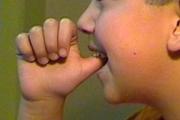 Thumbsucking: The newborns have a very natural and good established sucking mechanism. Those infants whose instinctive sucking is not satisfied will find some supplemental habbits. Those children who are breastfed by their mother for 9-18 months do not have generally this habbit.Research has shown that thumbsucking develops in the first weeks of the life due to hunger. During eruption of the teeth the pain caused by local irritations can be reduced through thumbsucking and thus may help teething. It disappeares with aing.
Thumbsucking: The newborns have a very natural and good established sucking mechanism. Those infants whose instinctive sucking is not satisfied will find some supplemental habbits. Those children who are breastfed by their mother for 9-18 months do not have generally this habbit.Research has shown that thumbsucking develops in the first weeks of the life due to hunger. During eruption of the teeth the pain caused by local irritations can be reduced through thumbsucking and thus may help teething. It disappeares with aing.
The reasons for thumbsucking:
- To suddenly wean the infant ,
- To stop the breastfeeding early
- To change the feeding habbits of the child by doing it with loger intervals
At the early stages for thumbsucking there is nothing to be done. To try to prevent the habbit will effect the phsiology of the child that is why it has to be avoided.An exct time can not be given to start to treat this habbit. Itmay vary from one child to another. The degree of the habbit and the opast of the child will effect the timing. Generally if thumsucking continues even after 3.5 yers of age the treatment has to begin.
The thumbsuckers depending on the time and number of fingers they suck will have misalignments and maloclusions. .
Pacifiers: Phsiologically and anatomcally suitable pacifiers are harmless till 1.5 years of age. In fact it is even a goog tool to distract the child from thumbsucking. If used overtime they may also cause some orthodontic problems.
Lying form: Lying form generally dictates the position of the lower jaw. And this gives us information about the position of the mandible for 8 hours during sleep.For instance those sleeping face down and those who sleep flat have different jaw positions.Those who sleep all the time on one side putting his hand and or frist between the pillow and his face tend to have orhodontic problems due to continous force applied on that side.
Habbits like bruxing,nailbiting,pencil biting,lip biting.
Early primary teeth losses
Teeth crowding related to peridontal problems
Malpositioning due to exractions
Malpositionings due to wisdom teeth’s compression of the dental arch
Genetic predisposition
Hormonal disorders, sistemic diseases.
What are the obtions for orthodontic treatment ?
- Fix Ortodontic Apliances: Are non removable solutions consisting of brackets and wires that go through the brackets which are made either fom metal or more esthtic material namely seramics.
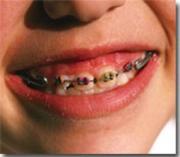
- Removable Ortodontic Apliances: Are appliances that the patient can take out themselves and are used generally for easier cases.
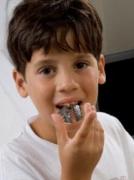
- Jaw Orthopedics: Is a subdivision which deals with the disturbed interrelations of the upper and lower jaws by applying extraorall appliances and aiming to restore the proper relationship of the jaws.Generally orthodontics and orthopedics go hand in hand restoring not only dental but the inerrelations of the jaws disturbances as well.
- Ortognatic Surgery: Cases the can not be corrected either with orthopedics or orthodontics are done by orthognatic surgery. Deformations of the face and jaws are either congenital or caused by an accident. These functional and esthetic problems that origininate from the incompatibility of the jaws to each other and to the face can be solved by highly technological advanced surgical techniques.
- Invisalign: Some less complex cases can nowadays be solved without the use of brackets and wires ,by only implementing transparent sleeves that are fabricated and hve to be worn 20 hours a day.Every treatment requires approximatelly 60 pair (upprer and lower jaw ) of these fabricated transparent sleeves.The treatment time is close to the fixed appliances with brackets. It differs from one case to another and it is between 6 to 24 months.
How are the teeth moving during orthodontic treatment?
If by means of arch wires ,springs or elastics force is applied on tooth then a motion is witnessed in the direction of the force. Temporarily there is a deposition of the bone in front of the moving tooth whereas an aposition takes place contrary to the direction of the motion. So the teeth take a new place,and the movement continues with this depositioning and apositioning of the bone tissue.
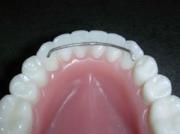 What is the maintenance therapy?
What is the maintenance therapy?
Right after tooth have been mobilized the peridontium which is the surrounding structures around the tooth do not stabilize and the bone does not maturate either.For that reason if the appliances are taken off teeth may migrate to their previous situations. To avoid it maintanence appliaces have to be fabricated.This phase of the treatment is called the maintanance treatment.During this phase the kid has to take care of the teeth properly and stic to the rules of not abondoning the treatment because oherwise there may be a relapse.
What are the guidelines to follow during orthodontic treatment?
There are some guidelines the kis have to follow in the orthodontic treatment.So have the parents the responsibility to closely watch their kids during the treatment
The guidelines are:
- Before orthodontic treatment all teeth with decays have to be treated and if gum problems exist it has to be fixed as well
- According to diagnosis either anremovable or fixed appliance has to be used. As mentioned previously it has to be taken care of perfectly by regular toothbrushing.Especially with fixed appliances the plaque accumulation is a more common problem.To avoid it oral hygiene instructions have to be followed.
- Generally after the treatment begins every month there will be controls. That’s why the biggest responsibility lies on the kid. The kids have to be willing to accept the treatment.Most of the time the pressure from the parents side has a negative effect on the child.
- The recommendations of the orthodontist have to be strictly foolowed.
- Appointments shouldn’t be missed
- In case the appliances breake off,fracture or at fix appliances the brackets or other elements of the appliances come off the patient immeadetely has to visit the doctor.
- At the maintanance phase the patient has to use the appliance according to how it was described..
- For oral hygiene maintanance superfloss,interdental brushes,special orthodontic brushes,oral rinses are inevitable
- The hard foods have to be cut instead of biting
- Crusty dessert may break and dislocate the brackets,that’s why should not be consumed during ortodontic treatment
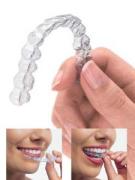 Is it possible to have invisible orthodontic treatment?
Is it possible to have invisible orthodontic treatment?
Nowadays it is possible with new techniques and materials to get rid of the brackets and wires which do not have a pleasant view. The brackets we use today may be tooth coloured, the wires as well and sometimes as it is with lingual orthodontics the brackets can also be bonded at the innerside of the teeth so that they are not recognized.
Invisible Braces (Invisalign)
The brackets and wires are to fix malocclusions or malpositioning of the teeh.But today in some indications we may use instead of traditional orthodontics the invisible appliances that we call the invialign system
The patented system works with multiple, clear, retrievable appl-iances.Your Invisalign treatment will consist of a series of aligners that you switch out about every two weeks. Each aligner is individually manufactured montswith exact calculations to gradually shift your teeth into place. And since your Invisalign system is custom-made for your teeth and your teeth only, with a plan devised by you and your dentist or orthodontist, you know you’ll end up with a smile that truly fits.The reason to chose the system is the better appearance compared to the traditional fixed appliances.Beside this as they are retrievable it is easier to clean the teeth after the meal.hey are comfortable and do not irritate gums,cheeks and tongue. ıt is non allergenic as it is sometimes the case with metallic bands,wires or brackets
Once your doctor decides your situation is suitable for Invisalign treatment, a treatment plan will be mapped out with your goals in mind. Then, impressions and pictures of your teeth will be taken for digitization purposes.
The impressions of your teeth will be digitized in order for your doctor to work with a computerized 3-D image of your teeth. Then, your doctor will plan your tooth movements throughout your entire treatment timeline. You’ll be able to see a virtual representation of your teeth before, during, and after completion of the Invisalign process so you can see what your smile should look like when you’re done with treatment.
From your doctor’s precise treatment plan, customized aligners are created with advanced technology for you to wear at each stage of your treatment. While the number of aligners varies for each individual situation, a full set of treatment typically includes 20-30 aligners per arch.
You should wear your aligners at all times, with the exception of eating and drinking, in order to complete your treatment in the timeline determined by you and your doctor. You’ll go in for occasional checkups, to monitor your progress and to receive your next set of aligners. During the entire treatment process, you’ll be able to watch your teeth gradually moving into place. Your smile will, little by little, move into something you’d like to show off. The people around you will be sure to notice your new-found confidence.
Every two weeks the aligner is changed with a new one.Your teeth will move towards the desired position and the treatment lasts until the goal is accomplished. Every 6 weeks you visit your dentist in order to check the treatment path.A typical invisalign treatment lasts between 9-15 months.Of course it differs from one case to another.
